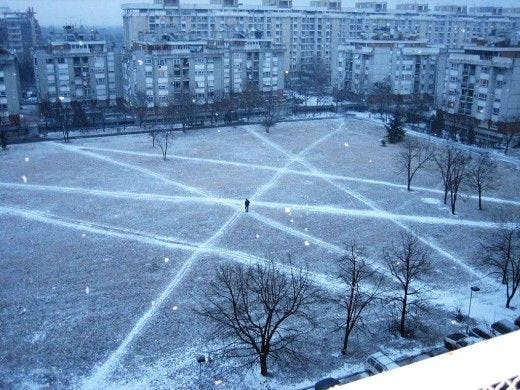Desire paths – paths & tracks made over time by the wishes & feet of walkers, especially those paths that run contrary to design or planning. Free-will ways.
In 1967, long before the term desire path was popularised, Richard Long, a 22-year-old student, walked in a straight line in a grassy field, there and back, until a path appeared. He then photographed his ephemeral sculpture, thus creating A Line Made By Walking. That photograph, and indeed the act itself behind it, became a seminal piece in the history of land art and conceptual art. The line was a record of his desire, time, persistence, regularity, and agenda. “My work has become a simple metaphor of life. A figure walking down his road, making his mark. It is an affirmation of my human scale and senses.”
When I was younger, I truly hated desire paths. I didn’t understand why people couldn’t just make the small extra effort to stay on the “real” path—the neatly paved sidewalks or designated trails—rather than ruining the grass. The sight of those worn, dry lines cutting through a lawn bothered me. They seemed lifeless, devoid of the vitality of nature, with their grey-beige tones standing in contrast to the lush green around them. To me, they symbolised destruction, a blatant disregard for the environment I cherished so deeply as a nature lover.
As I’ve grown, my perspective has shifted. I still love nature, but I’ve come to understand that desire paths are not mere acts of thoughtlessness or destruction. Instead, they are a visualisation of what people want and need—a silent, collective statement about human behaviour, preferences, and practicality. These unplanned routes represent a form of democratic expression, charted not by architects or urban planners but by the feet of those who navigate them every day. They reveal the gap between the designed and the desired, illustrating how imposed structures often fail to meet human needs.
In today’s reality, I see desire paths as a metaphor for the human spirit in pursuit of its wishes. They are evidence of our ability to forge new ways to find alternatives when the prescribed routes don’t align with our goals or values. With enough people walking the same unmarked trail—or simply enough time—these informal routes stop being dreams or deviations. They almost literally pave their way into reality, becoming as valid and enduring as the paved paths they once diverged from.
This metaphor feels especially on point in times of seeming darkness and uncertainty arising from the recent American election which left many feeling hopeless or disillusioned. In moments like these, desire paths seem like a glint of hope at the end of a dark tunnel. A reminder of our collective ability to form new ways when the old ones no longer work. They show that when enough people believe in an alternative path, they can make it materialise, no matter how ingrained the existing systems or structures might seem. The more people come together, the less time it takes for change to take root, and that is a deeply hopeful thought.
The tension between desire paths "destroying" and "creating" embodies transformation—sometimes, building something better requires dismantling the old. Desire paths may disrupt the grass, but they carve routes that better serve those who use them. Likewise, outdated societal norms and systems, while long-standing, often outlive their utility or equitability (if it was ever there). Progress doesn’t come from passivity but from disrupting the order, questioning norms, and resisting rules that don’t serve us—paving the way for something better.
Desire paths remind us that while systems and structures may be imposed upon us, we always retain the capacity to shape the world to better reflect our needs and aspirations. In this way, they offer a kind of quiet optimism, a proof of resilience in the face of rigidity, and a testament to the enduring power of collective will. Desire paths remind us that with collective effort and persistence, these changes can happen faster.




In the 70's, an architect friend used the term "paths of desire", and I have never forgotten it.
I like your metaphor of social change. At some time, the pressure will be so great, it will happen.
Very interesting!